Documents: Go to download!
- Owner's manual - (English)
- Getting to Know Your TV
- Connecting Your Devices
- Completing The First-Time Setup
- Using the On-Screen Menu
- Troubleshooting
Table of contents
User manual Television
Getting to Know Your TV
FRONT PANE

Rear Pane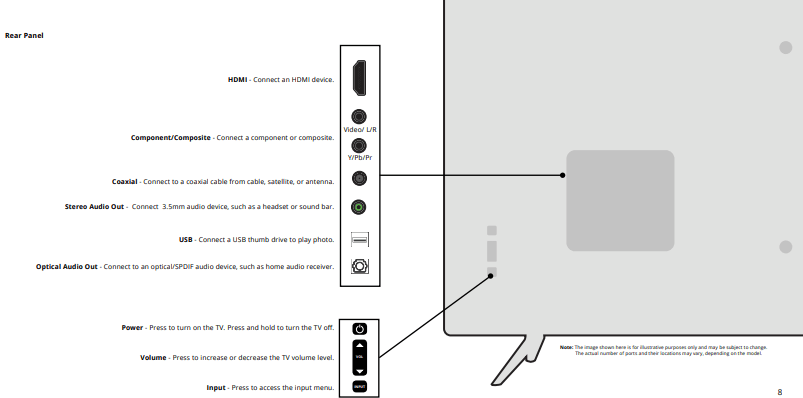
Connecting Your Devices
CONNECTING A DEVICE - AUDIO & VIDEO CABLE TYPES
Your TV can be used to display output from most devices.
- Verify that your device has a video port that matches an available port on the TV (HDMI, Component, etc.).
- Connect the appropriate cable (not included) to the TV and the device.
- Turn the TV and your device on. Set the TV’s input to match the connection you used (HDMI-1, HDMI-2, etc.).

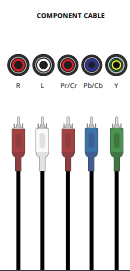


CONNECTING A DEVICE
D24hn-G9 includes a Component In/ AV In port that requires additional adapters (not included).
- Connect the appropriate cable (not included) to the TV and the device using an adapter (not included).
- Turn the TV and your device on. Set the TV’s input to match the connection you used (Component or Composite).
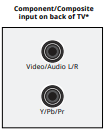
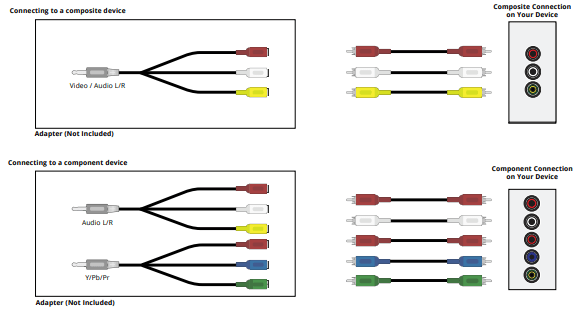
CONNECTING A DEVICE - AUDIO CABLE TYPES
Your TV can be output sound to an audio device, such as a receiver or sound bar.
- Verify that your device has audio port that matches an available port on the TV (Optical, RCA, etc).
- Connect the appropriate cable (not included) to the TV and the device.
- Turn the TV and your device on.
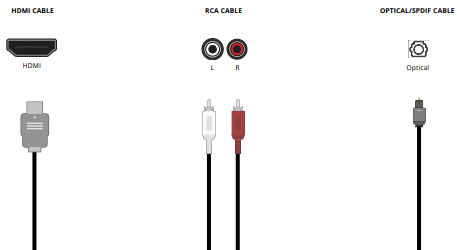
ALL-MOUNTING THE TV
To mount your TV on a wall, you will need a wall mount. Consult the information on this page to find the appropriate mount for your TV.
Be sure the mount you choose is capable of supporting the weight of the TV. After you have determined that you have the correct mount for your TV, you can begin the installation.
To install your TV on a wall:
- Disconnect any cables connected to your TV.
- Place the TV face-down on a clean, flat, stable surface. Be sure the surface is clear of debris that can scratch or damage the TV.
- If attached, remove the stands by loosening and removing the screws.
- Attach your TV and wall mount to the wall, carefully following the instructions that came with your mount. Use only with a UL-listed wall mount bracket rated for the weight/load of this TV.
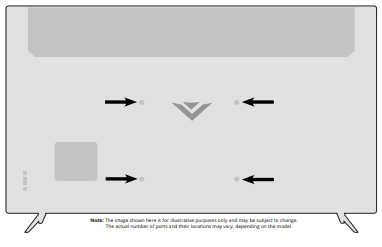
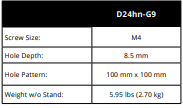
USING THE REMOTE

1. Input - Change the currently displayed input
2. Power - Turn Television on or off
3. Exit - Close the on-screen menu
4. Menu - Display the settings menu
5. Arrow - Navigate the on-screen menus
6. OK / Enter - Select the highlighted option / Confirm channel or passcode entered using the number pad.
See other models: E55-F1 M557-G0 M65-F0 D32f-F1 V705-G3
7. Back - Go to the previous on-screen menu
8. Info - Display the info window
9. Volume Up/Down - Increase or decrease the loudness of the audio
10. Closed Caption - Open the closed caption menu
11. Pic - Cycle through the different picture setting modes
12. Wide - Change the Television mode
13. Channel Up/Down- Change the channel
14. Mute - Turn the audio on or off
15. Last - Return to the channel last viewed
16. Number Pad - Manually enter a channel
17. Enter - Confirm channel entered using the number pad.
18. Dash - Use with number pad to manually enter a digital sub-channel. (For example, 18-4 or 18-5)
Replacing the Batteries
1. Find the notch on the back of the remote. Insert a coin and pry open the back cover.

2. Insert two batteries into the remote control. Make sure that the (+) and (-) symbols on the batteries match the (+) and (-) symbols inside the battery compartment.
3. Replace the battery cover.

In many places batteries cannot be thrown away or discarded with household waste. Please ensure you properly dispose of your batteries consistent with the laws and/or regulations where you live.
WARNING: keep the remote control batteries away from children. It may cause choking and/or lead to a fire or chemical burn if mishandled. Do not dispose of batteries infire. Replace only with batteries of the correct type.
Completing The First-Time Setup
The first time you turn on the TV, the on-screen instructions will guide you through each of the steps necessary to get your TV ready for use:
Before you begin the first-time setup:
- Your TV should be installed and the power cord should be connected to an electrical outlet.

1. Choose home use.
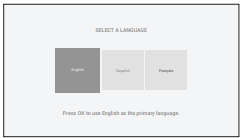
2. Choose your language
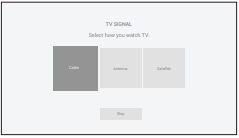
3. Select how you watch TV
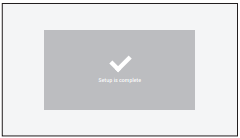
4. All set!
Using the On-Screen Menu
Your TV features an easy-to-use on-screen menu.
To open the on-screen menu, press the Menu button on the remote.
From this menu, you can:
- Adjust the Picture settings
- Adjust the Audio settings
- Set up the Timers
- Adjust the Channel settings
- Set up Closed Captioning
- Name and adjust Inputs
- Adjust TV setting
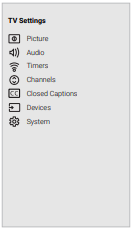
NAVIGATING THE ON-SCREEN MENU
To open the on-screen menu:
1. Press the Menu button on the remote.
2. Use the Arrow buttons to highlight a menu option, and press the OK button to select that option.
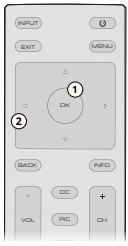
While navigating the on-screen menu, you can press the Back button at any time to return to the previous menu screen. The Exit button will close the on-screen menu.
CHANGING THE INPUT SOURCE
External devices such as DVD players, Blu-ray Players, and video game consoles can be connected to your TV. To use one of these devices with your TV, you must first change the input source using the Input menu.
To change the input sources:
- Press the Input button on the remote. The Input menu is displayed.
- Use the Right/Left Arrow buttons or the Input button on the remote to highlight the input you wish to view and press OK. The selected input is displayed.
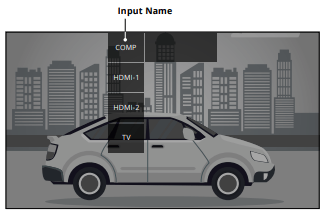
You can change the input names that appear on the Input menu to make your devices easy to recognize. See Renaming Devices on the Input Menu for more information.
CHANGING THE SCREEN ASPECT RATIO
The TV can display images in four different modes: Normal, Panoramic, Wide, and Zoom. Each mode displays the picture differently
Some programs have black bars on the top or sides of the picture so that the picture keeps its original shape. Examples include wide-screen movies and older television programs.
To change the screen aspect ratio:
1. Press the Wide button on the remote.
2. Use the Arrow buttons to highlight the aspect ratio you wish to view and press OK.
- Normal preserves the content’s original aspect ratio and size.
- Stretch expands a widescreen image to fill the screen from top to bottom and stretches it half as much from right to left. Figures appear tall and thin.
- Wide stretches a 4:3 aspect ratio picture to the edges of the screen. Since the picture is being stretched, the display image may appear distorted—figures appear short and fat. If the program is already formatted for widescreen viewing (1.85:1 or 2.35:1), then black bars will appear on the top and bottom of the display image.
- Zoom expands images evenly in all directions (33% taller and 33% wider) with black bars to fit the screen. A 720p image will fill a 1080p screen.
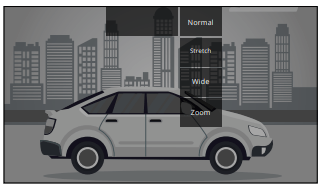
ADJUSTING THE PICTURE SETTINGS
Your TV can be adjusted to suit your preferences and viewing conditions.
To adjust the picture settings:
1. Press the Menu button on the remote. The on-screen menu is displayed.
2. Use the Arrow buttons on the remote to highlight Picture and press OK. The Picture menu is displayed.
3. Use the Arrow buttons on the remote to highlight Picture Mode, then use the Left/Right Arrow buttons to change the picture mode:
- Standard mode sets the picture settings to the default settings.
- Calibrated mode sets the picture settings to values ideal for watching TV in a brightly-lit room.
- Calibrated Dark mode sets the picture settings to values ideal for watching TV in a dark room.
- Vivid mode sets the picture settings to values that produce a brighter, more vivid picture.
- Game mode reduces throughput delays and optimizes the picture settings for displaying game console output.
- Computer mode optimizes the picture settings for displaying computer output.
To manually change each of the picture settings, use the Up/ Down Arrow buttons on the remote to highlight that picture setting, then use the Left/Right Arrow buttons to adjust the setting:
- Backlight - Adjusts the LED brightness to affect the overall brilliance of the picture. Backlight cannot be adjusted when starting from some picture modes.
- Brightness - Adjusts the black level of the picture. When this setting is too low, the picture may be too dark to distinguish details. When this setting is too high, the picture may appear faded or washed out.
- Contrast - Adjusts the white level of the picture. When this setting is too low, the picture may appear dark. When this setting is too high, the picture may appear faded or washed out. If the setting is too high or too low, detail may be difficult to distinguish in dark or bright areas of the picture.
- Color - Adjusts the intensity of the picture colors.
- Tint - Adjusts the hue of the picture. This setting is useful in adjusting the flesh tones in the picture. If flesh appears too orange, reduce the level of color before adjusting tint.
- Sharpness - Adjusts the edge sharpness of picture elements. It can be used to sharpen non-HD (high definition) content; however, it will not produce detail that does not otherwise exist.
When you have finished adjusting the picture settings, press the Exit button on the remote.

Adjusting the Color Temperature
Adjusting the color temperature changes the white balance of the picture.
To adjust the color temperature:
1. From the MORE PICTURE menu, use the Arrow buttons to highlight Color Temperature, and then press OK.
2. Use the Arrow buttons on the remote to highlight a color temperature preset and then press OK.
- Normal is optimized for television viewing.
- Cool produces a blue-hued picture.
- Computer optimizes the picture for use as a PC monitor
3. When you have finished adjusting the color temperature, press the Exit button on the remote.

Adjusting the Picture Mode Edit Settings
Picture Mode Edit Settings allow you to make precise adjustments to the picture and to create picture modes to save groups of picture settings.
To adjust the Picture Mode Edit settings:
1. From the PICTURE menu, use the Arrow buttons to highlight Picture Mode Edit, and then press OK. The PICTURE MODE EDIT menu is displayed.
2. Use the Arrow buttons to highlight the setting you wish to adjust, then press OK to change the setting:
- Save Picture Mode - Save a custom picture mode.
- Lock Picture Mode - Prevent changes to custom picture modes. Choose between On or Off.
- Reset Picture Mode† - Reset the picture mode settings to factory default values.

Saving a Custom Picture Mode
Custom picture modes allow you to save a group of custom settings for various viewing conditions and video sources.
- Changes made while on any preset picture mode will add an asterisk on the top right corner of the preset mode.
- The custom picture mode is not automatically saved.
To save a custom picture mode:
- From the PICTURE MODE EDIT menu, use the Arrow buttons to highlight Save Picture Mode, and then press OK. The SAVE PICTURE MODE menu is displayed.
- Use either on-screen keyboard to enter a name for your custom picture mode.
- Highlight Save and press OK.
- Press the Exit button to exit the menu screens.

Locking/Unlocking a Custom Picture Mode
Custom picture modes can be locked/unlocked with a unique PIN to prevent accidental changes to their settings.
To lock all custom picture modes:
- From the PICTURE MODE EDIT menu, use the Arrow buttons to highlight Lock Picture Mode, and then press OK. The LOCK PICTURE MODE menu is displayed.
- Use the Number Pad on your remote to enter a unique 4-digit PIN. If a system PIN is set, then lock/unlock. If no system PIN is set, then you will be prompted to set a PIN.
- Highlight Save and press OK
- Press the Exit button to exit the menu screens.
To unlock all custom picture modes:
- From the PICTURE MODE EDIT menu, use the Arrow buttons to highlight Lock Picture Mode, and then press OK. The LOCK PICTURE MODE menu is displayed.
- Use the Arrow buttons to select Off.
- Use the Number Pad on your remote to enter your 4-digit PIN.
- Make any desired changes to the picture modes.
- Then turn ON Lock Picture Mode.
- Press the Exit button to exit the menu screens.

Deleting a Custom Picture Mode
Custom picture modes that are no longer needed can be deleted.
To delete a custom picture mode:
- From the PICTURE MODE EDIT menu, use the Arrow buttons to highlight Delete Picture Mode, and then press OK. The DELETE PICTURE MODE window is displayed.
- Use the Left/Right Arrow buttons to highlight Delete and press OK.
- Press the Exit button to exit the menu screens.

Resetting a Picture Mode
A preset picture mode that has been edited can be restored to the factory default settings.
To reset a customized preset picture mode:
- From the PICTURE MODE EDIT menu, use the Arrow buttons to highlight Reset Picture Mode, and then press OK. The RESET PICTURE MODE window is displayed.
- Use the Left/Right Arrow buttons to highlight Reset and press OK.
- Press the Exit button to exit the menu screens.

To show or hide the Ramp Test Pattern:
1. From the Color Tuner menu, use the Arrow buttons to highlight Calibration Tests, and then press the Left/Right Arrow buttons until the RAMP TEST PATTERN menu is displayed.

2. Use the Arrow buttons on the remote to highlight Off. Use the Left/Right Arrow buttons to select the color for the ramp test pattern. Selecting a color immediately shows that color ramp.
—or—
To hide the Ramp Test Pattern, use the Left/Right Arrow buttons to highlight Off .
3. When you are finished, press the Exit button.
To show or hide the Uniformity Analyzer Test Pattern:
1. From the Color Tuner menu, use the Arrow buttons to highlight Calibration Test, and then press the Left/Right Arrow buttons until the UNIFORMITY ANALYZER TEST PATTERN menu is displayed.

2. Use the Arrow buttons on the remote to highlight Off. Use the Left/Right Arrow buttons to highlight On to show the Uniformity Analyzer Test Pattern.
—or—
To hide the Uniformity Analyzer Test Pattern, use the Left/Right Arrow buttons to highlight Off .
3. When you are finished, press the Exit button.
ADJUSTING THE AUDIO SETTINGS
To adjust the audio settings:
1. Press the Menu button on the remote. The on-screen menu is displayed.
2. Use the Arrow buttons on the remote to highlight Audio and press OK. The Audio menu is displayed.
3. Use the Arrow buttons to highlight the setting you wish to adjust, then press Left/Right Arrow buttons to change the setting:
- Speakers - Turns the built-in speakers On or Off.
- DTS TruSurround - Toggle between On or Off to hide or display the Equalizer slider. When set On, DTS TruSurround audio provides Surround Sound to the TV speakers.
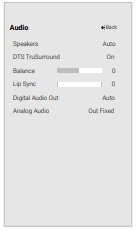
- Balance - Adjusts the loudness of the audio output from the left and right speakers.
- Lip Sync - Adjusts the synchronization between the display image and the accompanying audio track.
- Digital Audio Out - Changes the type of processing for digital audio out and HDMI ARC output when connected to a home theater audio system. Select Auto, PCM, Dolby D or Bitstream.
- Analog Audio Out - Sets the volume control properties for the RCA connector when connected to a home theater audio system. Select Variable if you are controlling the volume with the TV’s volume controls, or select Fixed if an external audio device (sound bar or AV receiver) will control the volume.
4. When you have finished adjusting the audio settings, press the Exit button on the remote.
SETTING TIMERS
Setting the Timer
When activated, the TV’s timer will turn the TV off after a set period of time.
- Press the Menu button on the remote. The on-screen menu is displayed.
- Use the Arrow buttons on the remote to highlight Timers and press OK. The TIMERS menu is displayed.
- Use the Left/Right Arrow buttons on the remote to highlight the period of time after which you want the TV to go to sleep: 30, 60, 90, 120, or 180 minutes. If you don’t want the sleep timer to activate, change the setting to Off.
- When you have finished setting the sleep timer, press the Exit button on the remote.

Setting the Auto Power Off Feature
To help save energy, your TV is set by default to turn off after 10 minutes without a video or audio signal. This feature can be deactivated.
To set the Auto Power Off feature:
- From the TIMERS menu, use the Up/Down Arrow buttons on the remote to highlight Auto Power Off.
- Use the Left/Right Arrow buttons on the remote to change whether the TV will turn off. If you don’t want the TV to turn off when there is no signal, change the setting to Off. Otherwise, select 10 minutes.
- When you have finished setting the auto power off time, press the Exit button on the remote.
SETTING UP CHANNEL
You can use the TV’s Channels menu to:
- Find Channels
- Select channels to skip
- Select Analog Audio mode
- Select the language for Digital Audio

Scanning for Channels
The TV may need to scan for channels before it can display programs and their associated information. A channel scan is required for free over-the-air channels (using an antenna) and cable channels from an outof-the-wall connection (without a cable box). Moving the TV to an area with different channels requires the TV to scan for channels again.
To perform an Auto Channel Scan:
- From the CHANNELS menu, highlight Find Channels, and press OK. The auto channel scan begins.
- Wait until the channel scan is 100% complete. Highlight Done and press OK.
- Press the Exit button on the remote.
If the channel scan is canceled, the channels that were already discovered are retained. A new channel scan will clear all channels.
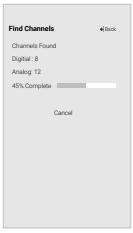
LISTENING TO ALTERNATE AUDIO
Changing the Analog Audio Language
Some analog over-the-air (free) and cable channels broadcast programs in more than one language. The TV’s Analog Audio feature allows you to listen to audio in an alternate language using Secondary Audio Programming (SAP).
To use the Analog Audio feature:
- From the Channels menu, highlight Analog Audio and press OK. The Analog Audio menu is displayed.
- Select Stereo, SAP (secondary audio programming), or Mono. Press OK.
- Press the Exit button on the remote.

To use the Digital Language feature:
- From the CHANNELS menu, highlight Digital Audio and press OK. The DIGITAL LANGUAGE menu is displayed.
- Select your preferred language: English, Spanish/Video Description, French. Press OK.
- Press the Exit button on the remote.
SETTING UP CLOSED CAPTIONING
Your TV can display closed captions for programs that include them. Closed captions display a transcription of a program’s dialogue.
To activate or deactivate closed captions:
- Press the Menu button on the remote. The on-screen menu is displayed.
- Use the Arrow buttons on the remote to highlight Closed Captions and press OK. The CLOSED CAPTIONS menu is displayed.
- Use the Arrow buttons on the remote to highlight Closed Captions and then use the Left/ Right Arrow buttons to select On or Off.
- Use the Arrow buttons on the remote to highlight either Analog or Digital Closed Captions.
- Use the Left/Right Arrow buttons on the remote to select the caption channel you wish to display, then press Exit.
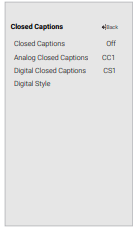
RENAMING DEVICES ON THE INPUT MENU
You can rename the inputs to make them easier to recognize on the Input menu. For example, if you have a DVD player connected to the Component input, you can rename that input to display “DVD Player.” See Changing the Input Source.
To change the name of an input:
1. Press the Menu button on the remote. The on-screen menu is displayed.
2. Use the Arrow buttons on the remote to highlight Input Settings and press OK. The INPUT SETTINGS menu is displayed.
3. Highlight the input device that you want to rename and press OK.
To use a preset input name:
- Highlight the Name Input row and press OK.
- Highlight the input name and use the Left/Right Arrow buttons on the remote to cycle through preset input names
—or—
To enter a custom name:
- Highlight the Name Input row and press OK.
- Enter your custom label using the on-screen keyboard.
- Highlight and press OK.
- The Input Name changes to show the custom name that you created.
4. When you have finished naming your input, press the Exit button on the remote.
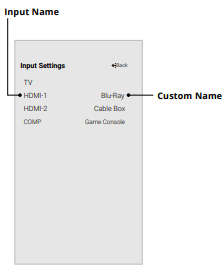
CHANGING THE TV SETTINGS
Using the SYSTEM menu, you can:
- View system information
- Change the on-screen menu language
- Set time zone and local settings
- Adjust the CEC settings
- Adjust to preserve Aspect Ratio or fill the screen
- Adjust accessibility settings
- Reset the TV settings & setup administrative controls
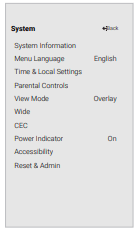
Viewing System Information
To view technical data and status information about your TV:
- Press the Menu button on the remote. The on-screen menu is displayed.
- Use the Arrow buttons on the remote to highlight System and press OK. The SYSTEM menu is displayed.
- Highlight System Information and press OK.
- Use the Up/Down Arrow buttons to scroll through the system information.
- When you are finished reviewing the system information, press the Exit button on the remote.
Changing the On-Screen Menu Language
Your TV can display the on-screen menu in different languages.
To change the on-screen menu language:
- Press the Menu button on the remote. The on-screen menu is displayed.
- Use the Arrow buttons on the remote to highlight System and press OK. The SYSTEM menu is displayed.
- Use the Arrow buttons on the remote to highlight Menu Language and press OK. The MENU LANGUAGE menu is displayed.
- Highlight your preferred language (English, Español, or Français) and press OK.
- Press the Exit button on the remote.
Changing the On-Screen Menu Language
Your TV can display the on-screen menu in different languages.
To change the on-screen menu language:
- Press the Menu button on the remote. The on-screen menu is displayed.
- Use the Arrow buttons on the remote to highlight System and press OK. The SYSTEM menu is displayed.
- Use the Arrow buttons on the remote to highlight Menu Language and press OK. The MENU LANGUAGE menu is displayed.
- Highlight your preferred language (English, Español, or Français) and press OK.
- Press the Exit button on the remote

Setting the Time and Local Settings
To ensure the correct time is displayed when you press the Info button, set the TV’s time zone:
- Press the Menu button on the remote. The on-screen menu is displayed.
- Use the Arrow buttons on the remote to highlight System and press OK. The SYSTEM menu is displayed.
- Use the Arrow buttons on the remote to highlight Time & Local Settings and press OK. The menu headed by the local date and time is displayed.
- Highlight Time Zone and press OK. The TIME ZONE menu is displayed.
- Highlight your time zone and press OK.
- Highlight Daylight Saving Time and press OK. The DAYLIGHT SAVING TIME menu is displayed. Choose On if it is currently Daylight Savings Time, Off if it is Standard Time, or Auto to have the system automatically detect Daylight Savings Settings.
- Press the Exit button on the remote.

To enable, disable, or adjust CEC settings:
- Set up your audio device and connect it to the HDMI-1(HDMI Arc) input on the TV
- On your audio device, select the HDMI ARC input.
- Press the Menu button on the remote. The on-screen menu is displayed.
- Use the Arrow buttons on the remote to highlight System and press OK. The SYSTEM menu is displayed.
- Use the Arrow buttons on the remote to highlight CEC and press OK. The CEC menu is displayed.
- Highlight CEC and press OK. Select a setting and then press OK. CEC - To use CEC, you must select Enable. Device Discovery - To determine if your device is connected and supports CEC, select Device Discovery and then press OK.
- Press the Exit button on the remote.
USING THE RESET & ADMIN MENU
You can use the TV’s RESET & ADMIN menu to restore the TV to its factory default settings as well as access other system settings.
Using the RESET & ADMIN, you can:
- Reset the TV to factory settings
- Start or stop the Store Demo Mode
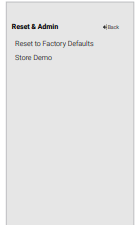
Restoring the TV to Factory Default Settings
All of the on-screen menu settings can be reset to the factory defaults.
To restore the TV to its factory default settings:
- Press the Menu button on the remote. The on-screen menu is displayed.
- Use the Arrow buttons on the remote to highlight System and press OK. The SYSTEM menu is displayed.
- Highlight Reset & Admin and press OK. The RESET & ADMIN menu is displayed.
- Highlight Reset to Factory Defaults and press OK. If you have changed the set system PIN, enter it now. The TV displays, “Select Reset to restore all TV settings to factory defaults and clear all account information.”
- Highlight Reset and press OK.
- Wait for the TV to turn off. The TV will turn back on shortly afterward and the setup process will begin.
Setting a System PIN
You can set a System Pin to lock content and picture modes as well as prevent accidental system resets. The first time you select System PIN code, you will need to create a PIN. To create a PIN.
- Press the Menu button on the remote. The on-screen menu is displayed.
- Use the Arrow buttons on the remote to highlight System and press OK. The SYSTEM menu is displayed.
- Highlight Reset & Admin and press OK. The RESET & ADMIN menu is displayed.
- Highlight System PIN Code and press OK.”
- Enter and confirm your new PIN.
- Highlight and select Save to confirm.
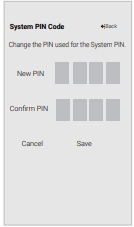
Playing USB Media
The USB Media Player allows you to connect a USB thumb drive to your TV and play photos.
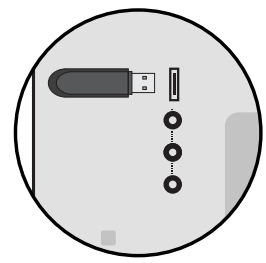
Note: The image shown here is for illustrative purposes only and may be subject to change. The actual number of ports and their locations may vary, depending on the model.
Displaying USB Media
To display your USB media:
1. Connect your USB thumb drive to the USB port on the side of the TV.
2. The TV will recognize the USB stick. Use the Arrow Keys on the remote to select the content you’d like to play.
Removing the USB Drive from the TV
To safely remove your USB drive from the TV:
3. Turn off the TV.
4. Disconnect your USB thumb drive from the USB port on the side of TV
Troubleshooting
HELP TOPICS
The remote is not responding.
- Make sure the batteries are properly inserted matching the - and + symbols.
- Replace the batteries with fresh ones.
The TV displays “No Signal.”
- Press INPUT button on the remote control to select a different input source.
- If you are using cable TV or antenna connected directly to the TV, scan for channels. See Scanning for Channels.
There is no power.
- Ensure the TV is plugged into a working electrical outlet.
- Ensure the power cable is securely attached to the TV.
- Press the Power/Standby button on the remote or on the back of the TV to turn the TV on.
The power is on, but there is no image on the screen.
- Ensure all cables are securely attached to the TV.
- Ensure all devices are connected correctly. Devices differ; see your device’s user manual for details.
- Adjust Brightness, Contrast, or Backlight. See Adjusting the Picture Settings.
- Press the INPUT button on the remote to select a different input source.
The sound is flat or dialog is not audible.
- Turn off Volume Leveling. See Adjusting the Audio Settings.
There is no sound.
- Press Volume Up on the remote control.
- Press the MUTE button on the remote to ensure mute is off.
- Check the audio settings. See Adjusting the Audio Settings.
- Check the audio connections of external devices (Blu-ray player, game console, cable/satellite box) that are connected to the TV.
- If you are using an antenna, the signal strength of the channel may be low. Ensure your antenna is connected securely to the TV and move the antenna around the room or close to a window for the best signal.
The colors on the TV don’t look right.
- Adjust the Color and Tint settings in the Picture menu. See Adjusting the Picture Settings.
- Select a pre-set picture mode. See Adjusting the Picture Settings. VIZIO recommends selecting Calibrated.
- Check all cables to ensure they are securely attached.
The image quality is not good.
- For the best image quality, view high-definition programs using digital sources. Connect your devices with HDMI cables.
- If you are using an antenna, the signal strength of the channel may be low. Ensure your antenna is connected securely to the TV and move the antenna around the room or close to a window for the best signal.
The picture is distorted.
- Move the TV away from electrical appliances, cars, and fluorescent lights.
- Ensure all cables are securely attached.
The buttons on the remote aren’t working.
- Ensure you are only pressing one button at a time.
- Point the remote directly at the TV when pressing a button.
- Replace the remote batteries with new ones. See Replacing the Batteries.
The TV image does not cover the entire screen.
If you are using TV, AV, or Component with 480i input, press the button  on the remote to change the screen mode.
on the remote to change the screen mode.
The TV has pixels (dots) that are always dark.
- Your HD TV is precision-manufactured using an extremely high level of technology. However, sometimes pixels may not display correctly. These types of occurrences are inherent to this type of product and do not constitute a defective product.
I see “noise” or static on the screen.
- When your TV’s digital capabilities exceed a digital broadcast signal, the signal is up-converted (improved) to match your TV’s display capabilities. This up-converting can sometimes cause irregularities in the image.
- If you are using an antenna, the signal strength of the channel may be low. Ensure your antenna is connected securely to the TV and move the antenna around the room or close to a window for the best signal.
When I change input source, the TV image changes size.
- The TV remembers the viewing mode on each input source. If the viewing mode on the new input source differs from the one on the input source you switch from, the difference may be noticeable.
- See Changing the Screen Aspect Ratio.
